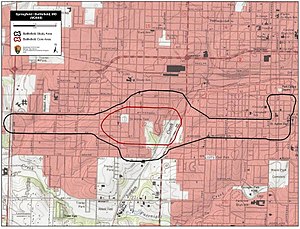| First Battle of Springfield | |||||||
|---|---|---|---|---|---|---|---|
| Part of the Trans-Mississippi Theater of the American Civil War | |||||||
 Springfield Battlefield | |||||||
| |||||||
| Belligerents | |||||||
|
|
| ||||||
| Commanders and leaders | |||||||
|
|
| ||||||
| Units involved | |||||||
| Missouri State Guard | ||||||
| Strength | |||||||
| c.300 | c.1,000 | ||||||
Location within Missouri | |||||||
The First Battle of Springfield was a battle of the American Civil War that took place on October 25, 1861, near Springfield, Missouri. Following the Battle of Wilson's Creek, the Missouri State Guard, a pro-Confederate militia organization, drove north and defeated a Federal (Union) force in the Siege of Lexington. Following the fighting at Lexington, Federal Major General John C. Frémont began a campaign that drove into southern Missouri. The main body of the Missouri State Guard fell back to Neosho, but a body of roughly 1,000 new recruits commanded by Colonel Julian Frazier was at Springfield. On October 24, Frémont sent a force raised as his bodyguard commanded by Major Charles Zagonyi on a scouting mission towards Springfield. After joining a cavalry force known as the Prairie Scouts at Bolivar, Zagonyi moved on towards Springfield on October 25.
Having lost the element of surprise in a clash with a small group of Missouri State Guardsmen, Zagonyi detoured his men to the west. At around 4:00 p.m., Zagonyi's men encountered Frazier's command. The Missouri State Guardsmen had taken up a defensive position on a partially wooded ridge. The exact details of the battle are unknown, but Zagonyi's men drove off Frazier's troops before entering Springfield and withdrawing north at around the time darkness fell. Zagonyi's post-battle report was intentionally inaccurate and was designed to inflate the contributions of his own troops at the expense of the Prairie Scouts. The action accomplished very little, and Federal troops occupied Springfield again two days later. Frémont was relieved of command in early November, and his successor called off the campaign and withdrew, allowing the Missouri State Guard to reoccupy Springfield, although they were driven out of Missouri in early 1862.
